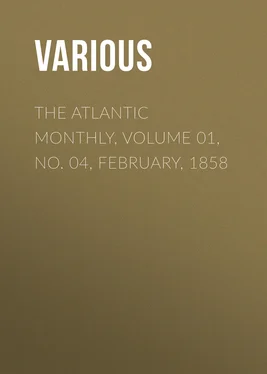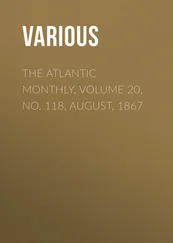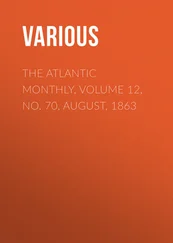Various - The Atlantic Monthly, Volume 01, No. 04, February, 1858
Здесь есть возможность читать онлайн «Various - The Atlantic Monthly, Volume 01, No. 04, February, 1858» — ознакомительный отрывок электронной книги совершенно бесплатно, а после прочтения отрывка купить полную версию. В некоторых случаях можно слушать аудио, скачать через торрент в формате fb2 и присутствует краткое содержание. Жанр: foreign_antique, periodic, foreign_edu, на английском языке. Описание произведения, (предисловие) а так же отзывы посетителей доступны на портале библиотеки ЛибКат.
- Название:The Atlantic Monthly, Volume 01, No. 04, February, 1858
- Автор:
- Жанр:
- Год:неизвестен
- ISBN:нет данных
- Рейтинг книги:3 / 5. Голосов: 1
-
Избранное:Добавить в избранное
- Отзывы:
-
Ваша оценка:
- 60
- 1
- 2
- 3
- 4
- 5
The Atlantic Monthly, Volume 01, No. 04, February, 1858: краткое содержание, описание и аннотация
Предлагаем к чтению аннотацию, описание, краткое содержание или предисловие (зависит от того, что написал сам автор книги «The Atlantic Monthly, Volume 01, No. 04, February, 1858»). Если вы не нашли необходимую информацию о книге — напишите в комментариях, мы постараемся отыскать её.
The Atlantic Monthly, Volume 01, No. 04, February, 1858 — читать онлайн ознакомительный отрывок
Ниже представлен текст книги, разбитый по страницам. Система сохранения места последней прочитанной страницы, позволяет с удобством читать онлайн бесплатно книгу «The Atlantic Monthly, Volume 01, No. 04, February, 1858», без необходимости каждый раз заново искать на чём Вы остановились. Поставьте закладку, и сможете в любой момент перейти на страницу, на которой закончили чтение.
Интервал:
Закладка:
But at length the feverish day
Like a passion died away,
And the night, serene and still,
Fell on village, vale, and hill.
Then the moon, in all her pride,
Like a spirit glorified,
Filled and overflowed the night
With revelations of her light.
And the poet's song again
Passed like music through my brain;
Night interpreted to me
All its grace and mystery.
SOMETHING ABOUT PICTURES
It is not surprising that pictures, with all their attraction for eye and mind, are, to many honest and intelligent people, too much of a riddle to be altogether pleasant. What with the oracular dicta of self-constituted arbiters of taste, the discrepancies of popular writers on Art, the jargon of connoisseurship, the vagaries of fashion, the endless theories about color, style, chiaro 'scuro, composition, design, imitation, nature, schools, etc., painting has become rather a subject for the gratification of vanity and the exercise of pedantic dogmatism, than a genuine source of enjoyment and culture, of sympathy and satisfaction,—like music, literature, scenery, and other recognized intellectual recreations. In these latter spheres it is not thought presumptuous to assert and enjoy individual taste; the least independent talkers will bravely advocate their favorite composer, describe the landscape which has charmed or the book which has interested them; but when a picture is the subject of discussion, few have the moral courage to say what they think; there is a self-distrust of one's own impressions and even convictions in regard to what is represented on canvas, that never intervenes between thought and expression, where ideas or sentiments are embodied in writing or in melody. Nor is this to be ascribed wholly to the technicalities of pictorial art, in which so few are deeply versed, but in a great measure to the incongruous and irrelevant associations which have gradually overlaid and mystified a subject in itself as open to the perception of a candid mind and healthy senses as any other department of human knowledge. Half the want of appreciation of pictures arises from ignorance, not of the principles of Art, but of the elements of Nature. Good observers are rare. The peasant's criticism upon Moreland's "Farm-yard"—that three pigs never eat together without one foot at least in the trough—was a strict inference from personal knowledge of the habits of the animal; so the surgeon found a head of the Baptist untrue, because the skin was not withdrawn somewhat from the line of decollation. These and similar instances show that some knowledge of or interest in the thing represented is essential to the appreciation of pictures. Sailors and their wives crowded around Wilkie's "Chelsea Pensioners," when first exhibited; French soldiers enjoy the minutiae of Vernet's battle-pieces; a lover can judge of his betrothed's miniature; and the most unrefined sportsman will point out the niceties of breed in one of Landseer's dogs. To the want of correspondence so frequent between the subject of a picture and the observer's experience may, therefore, be attributed no small degree of the prevalent want of sympathy and confident judgment. "Gang into an Exhibition," says the Ettrick Shepherd, "and only look at a crowd o' cockneys, some with specs, and some wi' quizzing-glasses, and faces without ae grain o' meaning in them o' ony kind whatsomever, a' glowering, perhaps, at a picture o' ane o' Nature's maist fearfu' or magnificent warks! What, I ask, could a Prince's-Street maister or missy ken o' sic a wark mair than a red deer wad ken o' the inside o' George's-Street Assembly-Rooms?"
The incidental associations of pictures link them to history, tradition, and human character, in a manner which indefinitely enhances their suggestiveness. Horace Walpole wove a standard collection of anecdotes from the lives and works of painters. The frescoes of St. Mark's, at Florence, have a peculiar significance to the spectator familiar with Fra Angelico's life. One of the most pathetic and beautiful tragedies in modern literature is that which a Danish poet elaborated from Correggio's artist career. Lamb's great treasure was a print from Da Vinci, which he called "My Beauty," and its exhibition to a literal Scotchman gave rise to one of the richest jokes in Elia's record. The pen-drawing Andre made of himself the night before his execution,—the curtain painted in the space where Faliero's portrait should have been, in the ducal palace at Venice,—and the head of Dante, discovered by Mr. Kirkup, on the wall of the Bargello, at Florence,—convey impressions far beyond the mere lines and hues they exhibit; each is a drama, a destiny. And the hard but true lineaments of Holbein, the aërial grace of Malbone's "Hours," Albert Durer's mediaeval sanctities, Overbeck's conservative self-devotion, a market-place by Ostade, Reynolds's "Strawberry Girl," one of Copley's colonial grandees in a New England farmer's parlor, a cabinet gem by Greuze, a dog or sheep of Landseer's, the misty depths of Turner's "Carthage," Domenichino's "Sibyl," Claude's sunset, or Allston's "Rosalie,"—how much of eras in Art, events in history, national tastes, and varieties of genius do they each foreshadow and embalm! Even when no special beauty or skill is manifest, the character of features transmitted by pictorial art, their antiquity or historical significance, often lends a mystery and meaning to the effigies of humanity. In the carved faces of old German church choirs and altars, the existent facial peculiarities of race are curiously evident; a Grecian life breathes from many a profile in the Elgin marbles, and a sacred marvel invests the exhumed giants of Nineveh; in the cartoons of Raphael, and the old Gobelin tapestries, are hints of what is essential in the progress and the triumphs of painting. Considered as a language, how definitely is the style of painters associated with special forms of character and spheres of life! It is this variety of human experience typified and illustrated on canvas, that forms our chief obligations to the artist; through him our perception of and acquaintance with our race, its individuality and career, its phases and aspects, is indefinitely enlarged. "The greatest benefit," says a late writer, "we owe to the artist, whether painter, poet, or novelist, is the extension of our sympathies . Art is the nearest thing to life; it is a mode of amplifying our experience and extending our contact with our fellow-creatures beyond the bounds of our personal lot."
The effect of a picture is increased by isolation and surprise. I never realized the physiognomical traits of Madame de Maintenon, until her portrait was encountered in a solitary country-house, of whose drawing-room it was the sole ornament; and the romance of a miniature by Malbone first came home to me, when an ancient dame, in the costume of the last century, with trembling fingers drew one of her husband from an antique cabinet, and descanted on the manly beauty of the deceased original, and the graceful genius of the young and lamented artist. Hazlitt wrote an ingenious essay on "A Portrait by Vandyck," which gives us an adequate idea of what such a masterpiece is to the eye and mind of genuine artistic perception and sympathy. Few sensations, or rather sentiments, are more inextricably made up of pleasure and sadness than that with which we contemplate (as is not infrequent in some old gallery of Europe) a portrait which deeply interests or powerfully attracts us, and whose history is irrevocably lost. A better homily on the evanescence of human love and fame can scarcely be imagined: a face alive with moral personality and human charms, such as win and warm our stranger eyes, yet the name, subject, artist, owner, all lost in oblivion! To pause before an interesting but "unknown portrait" is to read an elegy as pathetic as Gray's.
Читать дальшеИнтервал:
Закладка:
Похожие книги на «The Atlantic Monthly, Volume 01, No. 04, February, 1858»
Представляем Вашему вниманию похожие книги на «The Atlantic Monthly, Volume 01, No. 04, February, 1858» списком для выбора. Мы отобрали схожую по названию и смыслу литературу в надежде предоставить читателям больше вариантов отыскать новые, интересные, ещё непрочитанные произведения.
Обсуждение, отзывы о книге «The Atlantic Monthly, Volume 01, No. 04, February, 1858» и просто собственные мнения читателей. Оставьте ваши комментарии, напишите, что Вы думаете о произведении, его смысле или главных героях. Укажите что конкретно понравилось, а что нет, и почему Вы так считаете.












